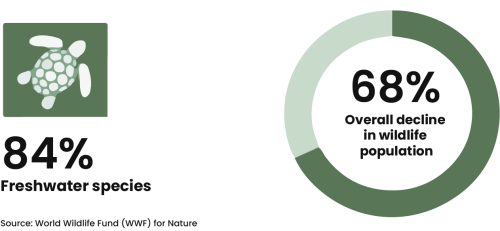MEET: THE TURTLE
THE MOST ENDANGERED VERTEBRATE ANIMAL ON THE PLANET
TURTLES ARE...
PARAGONS OF LONGEVITY
Having survived over 200 million years, including the dinosaur extinction event, turtles serve as a symbol for evolutionary success and longevity.
AMAZING PREDATORS
Without turtles, wetlands can turn into barren mudflats in just 8 months!
ECOSYSTEM ENGINEERS
Discarded turtle egg shells provide nourishment for beach grasses, which stabilize our precious shorelines.
WORLD'S BEST GARDENERS
With long distance seed dispersal, turtles ensure plant diversity and survival.
WATERWAY SANITATION EXPERTS
Freshwater turtles clean up waterways five times faster than natural decomposition processes.
UMBRELLA SPECIES
Tortoise burrows provide homes for 500 other species, ensuring the survival of hundreds of co-occcuring species.
State of the Earth
The world today has entered into the sixth mass extinction event since the dawn of life on Earth; and for the first time, a single species is responsible – humans.
Anthropogenic activities are altering the climate of the planet, destroying habitats, and changing the natural balance of the world completely.
More species are disappearing now than during the harshest ice ages that previously swept the Earth.
We believe it is our responsibility as humans to now work towards protecting the species who share our planet. The evidence is daunting, but it isn’t over.
At Turtle Island, we envision a bountiful planet, with abundant biodiversity of flora and fauna and thriving ecosystems. This vision, along with the practicality of science, drives us forward each and every day.
It is our joy to educate, inspire, and invite others to join the fight alongside us.
Wildlife population decline between 1970 and 2020

THE ARCHIVES
More Science, Please.
Our research focus points:
- Species conservation, ecology and evolution with a focus on turtles
- Combining protective measures for species conservation in the field and elsewhere
- Studying the genetic composition of populations, the optimal population sizes and the minimum viable
- Population size to guarantee the long-term survival of endangered species
- Studying the phylogeny and taxonomy of various species of tortoise and fresh water turtles
- Analysing the genetics of a species to gain more knowledge about ecology and conservation
- Improving turtle husbandry to conserve the species through captive breeding and species protection
- Research into veterinary medicine to fight reptile and amphibian diseases
Learn from the published work of our founders.
Fabio G. Cupul-Magaña, Nadin E. López-González, Ilse K. Barraza-Soltero, Torsten Blanck, Peter Praschag, Shannon DiRuzzo, Taggert G. Butterfield5, Armando H. Escobedo-Galván (2023): Snake shed skin consumed by Kinosternon vogti: a case of interspecific keratophagy: in press (Read article)
Shannon DiRuzzo, Peter Praschag, Lisa Miller, Micah Brodsk (2022): The Journal of Herpetological Medicine and Surgery, Volume 32, No. 4, 2022 pp. 262–270, DOI: 10.5818/JHMS-D-22-00002, Successful Treatment of Severe Ulcerative Dermatitis in an Aubry’s Flapshell Turtle (Cycloderma aubryi), (Read article)
Jorgewich-Cohen, G., Townsend, S. W., Padovese, L. R., Klein, N., Praschag, P., Ferrara, C. R., Ettmar, S., Menezes, S., Varani, A. P., Serano, J. and Sánchez-Villagra, M. (2022): Common evolutionary origin of acoustic communication in vertebrates. Nature Ecology and Evolution (read article)
Praschag, P. & R. Gemel (2022): A new subspecies of the Asiatic softshell turtle Amyda ornata (Gray, 1861) from its northern distribution range. Herpetozoa 35(1):81-93 (Read article)
Vamberger,M., Spitzweg, C., de Silva, A., Masroor, R., Praschag, P., Fritz U. (2020): Already too late? Massive trade in Indian star tortoises (Geochelone elegans) might have wiped out its phylogeographic differentiation. Amphibia-Reptilia 41 (2020): 133-138. (Read article)
Vamberger, M., Ihlow, F., Asztalos, M., Dawson, J. E., Jasinski, J. S., Praschag, P. and Fritz, U. (2020): So different, yet so alike: North American slider turtles (Trachemys scripta). Vertebrate Zoology, 70(1): 87-96. 70 (Read article)
Mazzoleni, S., Augstenová, B., Clemente, L., Auer, M., Fritz, U., Praschag, P., Protiva T., Velenský, P., Kratochvíl, L. and M. Rovatsos. (2019): Turtles of the genera Geomyda and Pangshura (Testudines: Geoemydidae) lack differentiated sex chromosomes: the end of a 40-year error cascade for Pangshura. Published online 2019 Feb 6. doi: 10.7717/peerj.6241 (Read article)
Spitzweg, C., Praschag, P., DiRuzzo, S. & U. Fritz (2018). Conservation genetics of the northern river terrapin (Batagur baska) breeding project using a microsatellite marker system Salamandra 54 (1): 63-70 (read article)
Gong, S., Vamberger, M., Auer, M., Praschag, P., and Fritz, U. (2018): Millennium-old farm breeding of Chinese softshell turtles (Pelodiscus spp.) results in massive erosion of biodiversity, The Science of Nature 105: 34. (read article)
Rovatsos, M., Praschag, P., Fritz, U. and Kratochvšl,L.(2017). Sex chromosomes enable molecular sexing in softshell turtles (Trionychidae). Scientific Reports 7, Article number: 42150 (2017) (read article)
Praschag, P., Ihlow F., Flecks M., Vamberger M., Fritz U. (2017). Diversity of North American map and sawback turtles (Testudines: Emydidae: Graptemys). Zool Scr . 2017 , (read article)
Moll, E.O., Platt, S.G., Chan, E.H., Horne, B.D., Platt, K., Praschag, P., Chen, P.N., and van Dijk, P.P. 2015: Batagur affinis (Cantor 1847) – Southern River Terrapin, Tuntong. In: Rhodin, A.G.J., Pritchard, P.C.H., van Dijk, P.P., Saumure, R.A., Buhlmann, K.A., Iverson, J.B., and Mittermeier, R.A. (Eds.). Conservation Biology of Freshwater Turtles and Tortoises: A Compilation Project of the IUCN/SSC Tortoise and Freshwater Turtle Specialist Group. Chelonian Research Monographs 5(8), (read article)
Weissenbacher, D. Preininger, R. Ghosh, A. G. J. Morshed, P. Praschag, 2015: Conservation breeding of the Northern river terrapin Batagur baska at the Vienna Zoo, Austria, and in Bangladesh, International Zoo Yearbook, DOI:10.1111/izy.12070 (read article)
Fritz, U., Gemel, R., Kehlmeier, Ch., Vamberger, M. and Praschag, P. 2014: Phylogeography of the Asian softshell turtle Amyda cartilaginea (Boddaert, 1770): evidence for a species complex. Vertebrate Zoology, 64(2): 229-243. (read article)
Bhupathy, S., Webb, R.G, and Praschag, P. 2014. Lissemys punctata (Bonnaterre 1789) – Indian Flapshell Turtle. In: Rhodin, A.G.J., Pritchard, P.C.H., van Dijk, P.P., Saumure, R.A., Buhlmann, K.A., Iverson, J.B., and Mittermeier, R.A. (Eds.). Conservation Biology of Freshwater Turtles and Tortoises: A Compilation Project of the IUCN/SSC Tortoise and Freshwater Turtle Specialist Group. Chelonian Research Monographs No. 5, pp. 076.1–12, doi:10.3854/crm.5.076.punctata.v1.2014, http://www.iucn-tftsg.org/cbftt/. (read article)
Deepak, V., Praschag, P., and Vasudevan, K. 2014: Vijayachelys silvatica (Henderson 1912) – Cochin Forest Cane Turtle. In: Rhodin, A.G.J., Pritchard, P.C.H., van Dijk, P.P., Saumure, R.A., Buhlmann, K.A., Iverson, J.B., and Mittermeier, R.A. (Eds.). Conservation Biology of Freshwater Turtles and Tortoises: A Compilation Project of the IUCN/SSC Tortoise and Freshwater Turtle Specialist Group. Chelonian Research Monographs No. 5, pp. 078.1–7, doi:10.3854/crm.5.078.silvatica.v1.2014, http://www.iucn-tftsg.org/cbftt/. (read article)
Kuchling G., Goode E., Praschag P. 2013. Endoscopic Imaging of Gonads, Sex Ratio, and Temperature Dependent Sex Determination in Juvenile Captive Bred Radiated Tortoises Astrochelys radiata. In Castellano C. M., Randriamahazo H., Lewis R. E., Mittermeier R. A., Hudson R., Rhodin A. G. J. (Eds.), Turtles on the Brink in Madagascar. Chelon Res Monographs No. 6,pp. 113-118, doi: 10.3854/crm.6. Lunenburg, Massachusetts: Chelonian Research Foundation (read article)
Liebing N., Praschag P., Gosh R., Vasudevan K., Rashid SMA, Rao D-Q, Stuckas H & U. Fritz (2012): Molecular phylogeny of the softshell turtle genus Nilssonia revisited, with first records of N. formosa for China and wild-living N. nigricans for Bangladesh. Vertebrate Zoology, 62: 261-272. (read article)
Fritz, U., Alcalde, L., Vargas-Ramírez, M., Goode,. E. V., Fabius-Turoblin, D. U. and Praschag, P. (2012), Northern genetic richness and southern purity, but just one species in the Chelonoidis chilensis complex. Zoologica Scripta, 41: 220–232. doi: 10.1111/j.1463-6409.2012.00533.x (read article)
Praschag, P., Stuckas, H., Päckert, M., Maran, J. & U. Fritz (2011): Mitochondrial DNA sequences suggest a revised taxonomy of Asian flapshell turtles (Lissemys Smith, 1931) and the validity of previously unrecognized taxa (Testudines: Trionychidae). Vertebrate Zoology, 61: 147-160. (read article)
Kuchling, G., E. Goode & P. Praschag (2011): Endoscopic Imaging of Gonads, Sex Ratio and Temperature Dependent Sex Determination in Captive Bred Juvenile Burmese Star Tortoises Geochelone platynota. – Asian Herpetological Research 2 (4): 240–244. (read article)
Das, I., Sengupta, S., and Praschag, P. (2010). Pangshura sylhetensis Jerdon 1870 – Assam roofed turtle. In: Rhodin, A.G.J., Pritchard, P.C.H., van Dijk, P.P., Saumure, R.A., Buhlmann, K.A., Iverson, J.B., and Mittermeier, R.A. (Eds.). Conservation Biology of Freshwater Turtles and Tortoises: A Compilation Project of the IUCN/SSC Tortoise and Freshwater Turtle Specialist Group. Chelonian Research Monographs No. 5, pp. 046.1–046.6 (read article)
Praschag, P., Gibbons, P., Boyer, T., Wellehan, J., Garner, M., 2010. An outbreak of intranuclear coccidiosis in Pyxis spp. tortoises. In: Proceedings, 8th Annual Symposium on the Conservation and Biology of Tortoises and Freshwater Turtles, Orlando, FL, USA, 32-33. (read article)
Moll, E.O., Platt, K., Platt, S. G., Praschag P., & P.P. van Dijk, (2009): Batagur baska (Gray, 1830) – Northern River Terrapin. Conservation Biology of Freshwater Turtles and Tortoises: A compilation project of the IUCN/SSC Tortoise and Freshwater Turtle Specialist Group. A.G.J. Rhodin, P.C.H. Pritchard, P.P. van Dijk, R. A. Saumure, K. A. Buhlmann & J.B. Iverson, eds. Chelonian Research Monographs, 5: 10 pp. (read article)
Praschag, P., R. Holloway, A. Georges, M. Päckert, A. K. Hundsdörfer & U. Fritz (2009): A new subspecies of Batagur affinis (Cantor, 1847), one of the world’s most critically endangered chelonians (Testudines: Geoemydidae). – Zootaxa 2233: 57-68. (read article)
Praschag, P., Hundsdörfer, A.K. & U. Fritz (2009): Further specimens and phylogenetic position of the recently described leaf turtle species Cyclemys gemeli (Testudines: Geoemydidae). Zootaxa, 2008: 29-37. (read article)
Praschag, P., Sommer, R. S., McCarthy, C., Gemel, R. & U. Fritz, (2008): Naming one of the world’s rarest chelonians, the southern Batagur. Zootaxa 1758:61-68. (read article)
Praschag, P., Hundsdörfer, A.K. & U. Fritz (2007): Phylogeny and taxonomy of endangered South and South-east Asian freshwater turtles elucidated by mtDNA sequence variation (Testudines: Geoemydidae: Batagur, Callagur, Hardella, Kachuga, Pangshura). Zoologica Scripta 36: 429–442. (read article)
Praschag, P., Hundsdörfer, A.K., Reza, A.H.M.A. & U. Fritz (2007):
Genetic evidence for wild-living Aspideretes nigricans and a molecular phylogeny of South Asian softshell turtles (Reptilia: Trionychidae: Aspideretes, Nilssonia). Zoologica Scripta 36 (4): 301-310 (read article)
Praschag, P., Schmidt, C., Fritzsch, G., Müller, A.., Gemel, R. & U. Fritz (2006): Geoemyda silvatica, an enigmatic turtle of the Geoemydidae (Reptilia: Testudines), represents a distinct genus. – Organisms Diversity & Evolution 6 (2): 151-162. (read article)
Gemel, R., Praschag, P. (2003): On the nomenclature and vernacular names of recent Aspideretes species (Reptilia, Testudines, Trionychidae). Zoologische Abhandlungen – Staatliches Museum fur Tierkunde in Dresden 53(1):93-105. (read article)
Praschag, P. & R. Gemel (2002): Identity of the black softshell turtle Aspideretes nigricans (Anderson 1875) with remarks on related species. Faun. Abh. Mus. Tierk. Dresden 23: 87-116 (read article)
Praschag, P. & G. Fachbach (2001): “Beiträge zur Kenntnis der Assam-Dachschildkröte, Kachuga sylhetensis (Jerdon 1870) (Reptilia: Testudines: Bataguridae)” Salamandra 37(3): 129-148 [“Contributions to the knowledge of the Assam roofed turtle, Kachuga sylhetensis (Jerdon, 1870)”] (read article)
Melita Vamberger, Cäcilia Spitzweg, Anslem de Silva, Rafaqat Masroor, Peter Praschag, Uwe Fritz (


